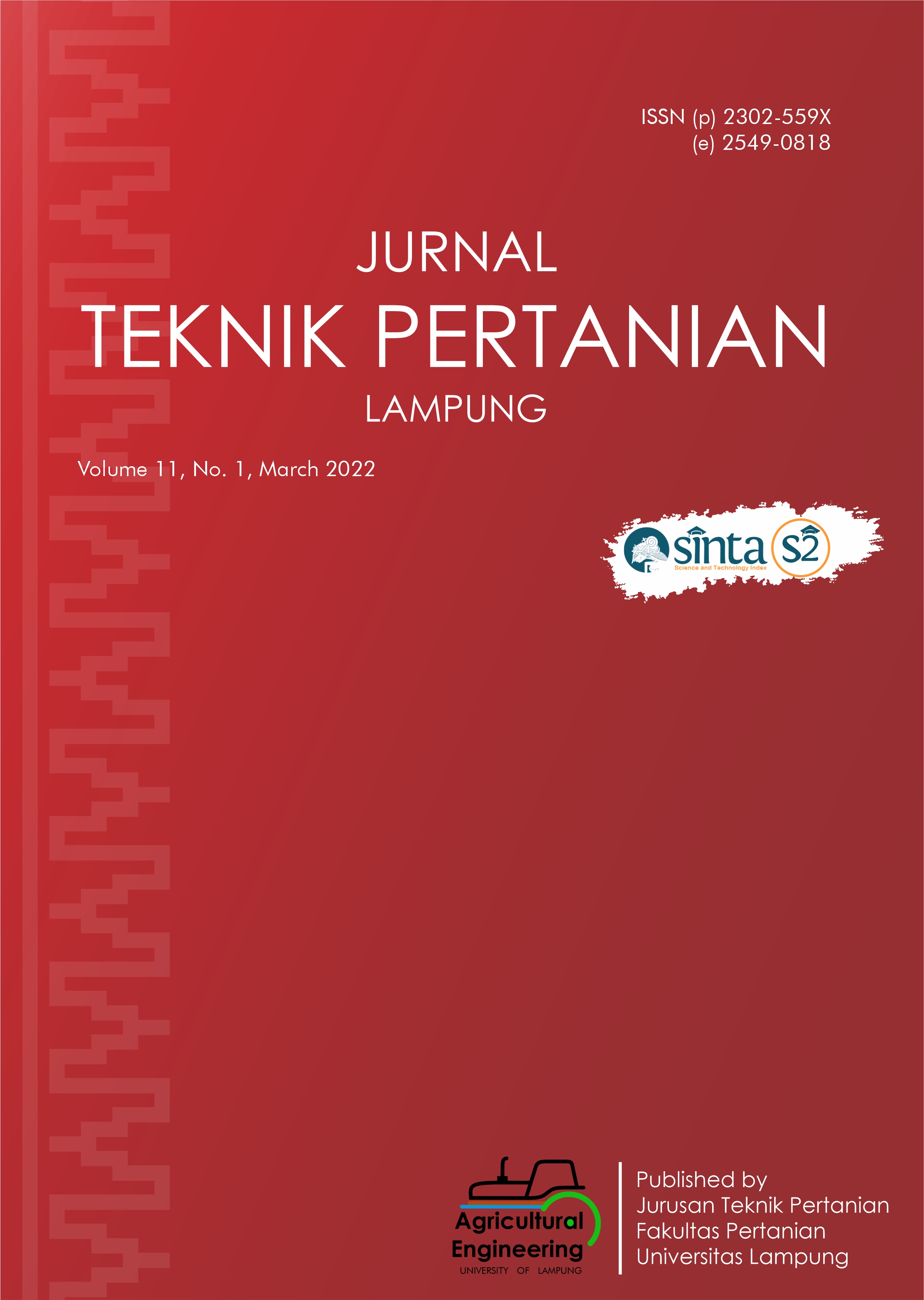Utilization of Lerak Juice (Sapindus rarak DC) as Natural Surfactant in the Liquid Washing Soap Production
DOI:
https://doi.org/10.23960/jtep-l.v11i1.24-34Abstract
Before detergent was commonly used, a natural cleanser which function is to help people to clean several things in their houses was Lerak berry (Sapindus Rarak DC). This berry contains saponins (28%) which can be used as the ingredient for shampoo, soap, and other kind of cleaning agents. Dilutting Lerak juice into soap base will produce liquid washing soap which can be an alternative to reduce the use of detergents. This study aims at finding the best treatment, balance ratio of Lerak juice (2:1; 3:2; 1:1; 2:3), and diluting method for the soap base (heating and non-heating) to be used for producing liquid washing soaps with the best characteristic. This study uses two-factor randomized block design method which later be analyzed using ANOVA. Organoleptic testing of the hedonic quality to the color, scent, foam quantity, cleaning-power, the after-effects impression, and the general assessment of the liquid washing soaps results a 2:1 Lerak juice balance ratio with heating method is found to be the best treatment for diluting method. The balance ratio affects the consistency and viscosity which also affects the density, pH, and water holding capacity, but does not affect the foams stability.
Keywords: Lerak, Liquid Washing Soap, Sapindus Rarak, Surfactant
References
Agustina, S., Wuryanto, W., Suratmono, S. (2005). Biodegradasi Dan Toksisitas Deterjen. Jurnal Kimia dan Kemasan, 27(2): 27: 1-7. DOI: 10.24817/jkk.v0i0.3580
Bidillah, S.A., Rumape, O., & Mohammad, E. (2017). Optimasi Waktu Pengadukan Dan Volume KOH Sabun Cair Berbahan Dasar Minyak Jelantah. Jurnal Entropi, 12(1): 55-60.
de Garmo, E.G., Sullivan, W.G., & Cerook, J.R. (1984). Engineering Economy. 7th edition. Macmilland Publ.Co. NewYork, USA.
Exerowa, D., & Kruglyakov, P.M. (1998). Foam and Foam Films: Theory, Experiment, Application. Elsevier. Netherlands.
Fatmawati, F., Rohman, G.A.N., & Mahfud, M. (2016). Proses Pembuatan Methylester (Biodiesel) Dari Minyak Kelapa Menggunakan Katalis NaOH Konsentrasi Rendah Dengan Bantuan Gelombang Mikro (Microwave). Prosiding Konser Karya Ilmiah (ISSN: 2460-5506), Surabaya: 23-28.
Febriyenti, F., Sari, L.I., & Novita, R. (2014). Formulasi Sabun Transparan Minyak Ylang-Ylang Dan Uji Efektivitas Terhadap Bakteri Penyebab Jerawat. Jurnal Sains Farmasi & Klinis, 1(1): 61-71. DOI: 10.29208/jsfk.2014.1.1.13
Fitriyah, I. (2018). Prototipe Sabun Cair Nanoemulsi Berbasis Ekstrak Lerak (Sapindus rarak DC) sebagai Surfaktan dan Antibakteri. Skripsi. Universitas Brawijaya. Malang
Frost, V.S., Stiles, J.A., Shanmugan, K.S., & Holtzman, J. (1982). A Model for Radar Images and Its Application to Adaptive Digital Filtering of Multiplicative Noise. IEEE Transactions on Pattern Analysis and Machine Intelligence, PAMI-4(2): 157-166. DOI: 10.1109/TPAMI.1982.4767223
Horowitz, A. (2013). Soap Making Made Easy : A Beginner’s Guide To Making Great Soap. Power of One. United States of America.
Martin, A., Swarbick, J., & Cammantara, A. (1993). Farmasi Fisik Jilid 2. UI Press. Jakarta
Mitsui, T. (1997). New Cosmetic Science. Elseveir Science B.V., Amsterdam, Netherland.
Naomi, P., Gaol, A.M.L., & Toha, M.Y. (2013). Pembuatan Sabun Lunak Dari Minyak Goreng Bekas Ditinjau Dari Kinetika Reaksi Kimia. Jurnal Teknik Kimia, 2(19): 42-48.
Nurhadi, S.C. (2012). Pembutan Sabun Mandi Gel Alami Dengan Bahan Aktif Mikroalga Chorrela Pyrenoidosa Beyerick dan Minyak Atsiri Lavandula Lativolia Chaix. Skripsi. Fakultas Sains Dan Teknologi. Universitas Ma Chung, Malang
Oktari, S.A.S.E., L.P. Wrasiati, N.M. Wartini. 2017. Pengaruh Jenis Minyak dan Konsentrasi Larutan Alginnat Terhadap Karakteristik Sabun Cair Cuci Tangan. Jurnal Rekayasa dan Manajemen Agroindustri, 5(2):47-57.
Putra, E.P.D., Ismanto, S.D., & Silvy, D. (2019). Pengaruh Penggunaan Gel Lidah Buaya Pada Pembuatan Sabun Cair Dengan Pewangi Minyak Nilam. Jurnal Teknologi Pertanian Andalas, 23(1): 10-18. DOI: 10.25077/jtpa.23.1.10-18.2019
Rangkuti, M.R. (2017). Penetapan Kadar Air Dan Bilangan Penyabunan Pada Minyak Kelapa Curah Dan Minyak Kelapa Bermerek. Skripsi. Universitas Sumatera Utara. Medan.
Sari, N.W.T.K., Putra, G., & Wrasiati, L.P. (2019). Pengaruh Suhu Pemanasan Dan Konsentrasi Carbopol Terhadap Karakteristik Sabun Cair Cuci Tangan. Jurnal Rekayasa dan Manajemen Agroindustri, 7(3): 429-440. DOI:10.24843/JRMA.2019.v07.i03.p10.
Sinko, P.J. (2006). Martin Farmasi Fisika dan Ilmu Farmasetika. Edisi 5. Penerbit Buku Kedokteran. Jakarta
Udarno, L. (2009). Lerak (Sapindus rarak) Tanaman Pengganti Sabun. Warta Penelitian dan Pengembangan Tanaman Industri, 15(2): 7-8.
Wade, A., & Weller, P.J. (1994). Handbook of Pharmacheutical Excipients. 2nd Edition. Pharmacheutical Press. London, UK
Widyasanti, A., & Ramadha, C.A. (2018). Pengaruh Imbangan Aquades Dalam Pembuatan Sabun Mandi Cair Berbahan Virgin Coconut Oil (VCO). Agrisaintifika Jurnal Ilmu-Ilmu Pertanian, 2(1): 35-50. DOI: 10.32585/ags.v2i1.217.
Wulandari, M.A. 2016. Lerak Detergen: Pemanfaatan Buah Lerak (Sapindus rarak DC) sebagai Bahan Alternatif Sabun Pencuci Pakaian dengan Aroma Jeruk (Citrus sp.). Tugas Akhir. Fakultas Pertanian, UNS, Surakarta.
Yulianti, M., & Husada, V.M.S. 2019. Optimasi Mutu dan Daya Detergensi Sediaan Detergen Cair Ekstrak Biji Mahoni (Switenia Mahagoni L). Jurnal Kimia Dan Pendidikan Kimia (JKPK), 4(2): 65-76. DOI: 10.20961/jkpk.v4i2.32750.
Downloads
Published
Issue
Section
License
- Authors who publish with this journal agree to the following terms:
- Authors retain copyright and grant the journal right of first publication with the work simultaneously licensed under a Creative Commons Attribution-ShareAlike 4.0 International Lice that allows others to share the work with an acknowledgement of the work's authorship and initial publication in this journal.
- Authors are able to enter into separate, additional contractual arrangements for the non-exclusive distribution of the journal's published version of the work (e.g., post it to an institutional repository or publish it in a book), with an acknowledgement of its initial publication in this journal.
- Authors are permitted and encouraged to post their work online (e.g., in institutional repositories or on their website) prior to and during the submission process, as it can lead to productive exchanges, as well as earlier and greater citation of published work (See The Effect of Open Access).
Jurnal Teknik Pertanian Lampung

JTEPL is licensed under a Creative Commons Attribution-ShareAlike 4.0 International License.

